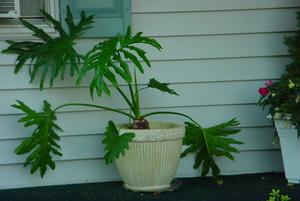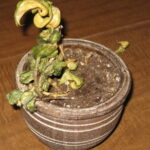Do you kill any houseplant that you are put in charge of? Are you mystified by how some people can turn a pile of browning leaves into a flourishing thing of beauty? If you take a little time and learn about the care of houseplants, you will find that you, too – yes you! – can grow stunning plants that beautify your home or office.
A few facts make it easy to grow houseplants
There are a few things that any plant needs in order to grow and thrive. Water, light, a good pot and a little fertilizer. And that’s really it. If you understand the basics about the needs of your plants, you will be rewarded with beauty for years to come. A couple of good websites for your reference are www.plantcare.com and www.houseplants-flowers-online-caretips.com.
Watering Your House Plants
Most people kill plants with water. It’s either too much or too little. But how do you know how much is enough? It’s really no mystery. Water your plants when the soil at the top feels fairly dry. This is the best rule of thumb for beginners. Once you get the hang of it, there are plants which require more or less water or horrors – misting. If you start with this simple rule, however, you should be fine.
When you water you plants, you will want to see a little bit of the water run out of the bottom of the pot and into its saucer. That is how you will know you have watered enough. Don’t water again until the top of the soil feels pretty dry. If you over water your plants, the roots will stay too moist and rot.
Your plant may tell you that this is not quite enough water and become droopy. This is how you will know if it needs more frequent watering. The rule of the green thumb here is that if you are in doubt, don’t water. Wait until the plant is a little drier.
Light
The correct light for your plant can be just a little bit tricky. But just a little. Most plants like light, but they do not want to bake in a south facing window all day. If you keep that one rule in mind, you should do pretty well.
A north window will not give your plants too much light. Sometimes, though, it will be bright enough for low-light loving plants like dieffenbachia, peace lily or snake plants. If the leaves on your plant turn a dark green, the spot is probably too dark. Try another window.
An east or west window will get direct sunlight for either the morning or afternoon. In or near one of these windows is probably a great location for many plants. Here they will get some direct light, but not all day long. Too much sun will burn and wilt your plants. If you notice that your plants are turning a light green, then they are probably getting to much sun. Try moving them further away from the window.
A bright spot that is not in a window may also be good for some low-light loving plants. Some philodendrons, peace lilies, snake plants or pathos may like it here.
A south window is a good place for only a few plants. If the window gets direct sun all day, be sure to check them frequently for dryness. Plants such a cactus will do well here. Maybe African Violets as well.
A Good Pot
Every plant needs the proper pot. If the pot is too big, it will stay too moist and the plant’s roots will rot. If the plant is root bound, it will not be able to take in enough water and will no longer have much soil from which to gain nutrients. The green thumb rule is to repot your plants every year or two. But if that sounds overwhelming, don’t worry about it for now. If you are successful and get the plant bug, you can delve in to that later.
You can also dust a small amount of new potting soil on top of your plants instead of repotting them if the pot size is still ok. This will give them fresh soil and nutrients. The thing to be careful about is building too much soil up and rotting the stems. Just a dusting will do wonders for your plants. Don’t add more than a quarter inch or so across the whole top of the pot. You can use any generic potting soil mix.
Fertilizing
You will want to buy some fertilizer. There are many kinds with confusing numbers on the label. Just buy an all purpose fertilizer. You don’t have to get fancy with different types or fish emulsion. A generic fertilizer will do just fine. Liquids are quite easy to add into their water.
Just like humans need vitamins and nutrients to live and thrive, house plants need fertilizer. This is like their vitamin pill. Follow the label directions carefully. Too much fertilizer will burn your plants. As with watering, too little is better than too much. You may want to halve the dosage and fertilize with every watering. Even with that low dose, you may want to skip some fertilizing during the winter. Maybe only once or twice a month is necessary. You can go back to the normal regimen at the very beginning of Spring.
Maintenance
There is very little maintenance that you will have to do for your house plants. You will want to keep their leaves clean. Every plant will love a bath from time to time, but if that is too advanced for you don’t worry about it. Just gently wipe any leaves that accumulate a lot of dust or pollen.
Snip off browning leaves. Even an expert house plant keeper will have some leaves which turn brown. Don’t panic. This is just a normal part of growth. The older leaves will turn brown and fall off. Try to keep these trimmed off so that the plant doesn’t have to waste energy trying to nurse the leaf. It will fall off anyway.
Enjoy Your New House Plants
This should be enough to get you started on a new hobby. You can check www.thegardenhelper.com/houseplants if you want some more informaton. You may find yourself getting excited about how well your plant is growing and looking forward to buying new ones. Start with easy plants, follow these few simple rules and you should be rewarded with lovely greenery. Enjoy your green thumb and your beautiful house plants.







